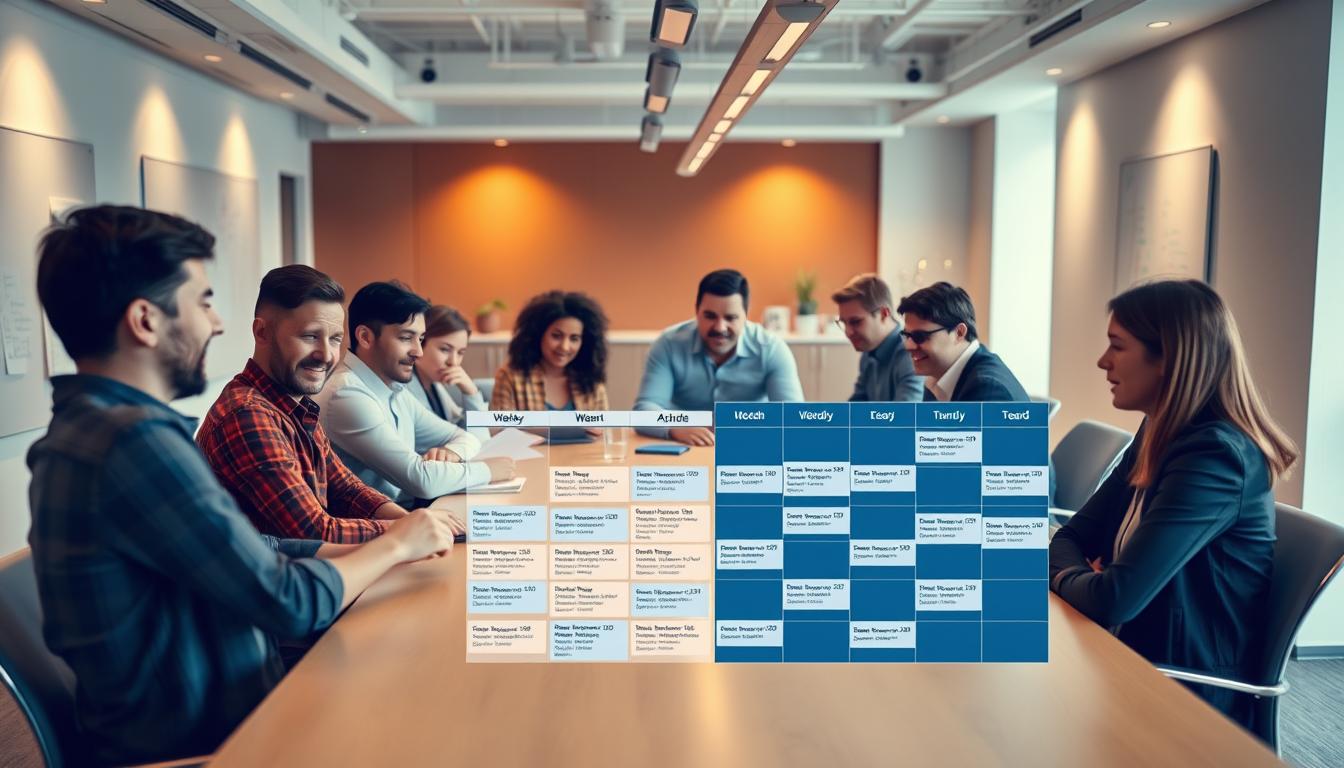In our quick-moving work world, we have more meetings than ever. But many find these meetings don’t help much. They turn into places where true problems with meetings are missed. Rather than help us work together, too many meetings make us tired and annoyed. This hurts how happy and energetic we feel at work. In this piece, we’ll look into why meetings fail and how to make them better. This will help us all get more done.
The Growing Epidemic of Unproductive Meetings
Today, unproductive meetings are a big problem in workplaces, causing trouble in many sectors. Workers in the U.S. and Europe say they have too many meetings. This makes them tired and less interested in their work. A lot of people think many of these meetings aren’t needed.
Studies show that bosses spend about 23 hours a week in meetings. That’s way more than in the 1960s. This increase hurts how well workplaces do. Even though there are ways to manage time better, companies keep doing things the old way. They find it hard to use new ideas that could make meetings work better.
Understanding the Impact of Unproductive Meetings on Organizations
Unproductive meetings can greatly affect how well an organization does. They cost about $37 billion each year. This huge amount shows that not-so-great meetings can waste about 31 hours of a worker’s monthly time. This takes away important resources.
Too many meetings can lead to a lot of frustration. This bad feeling can make employees less interested in their work. They may also feel blocked and not eager to add to their team. This situation can stop new ideas, which are crucial for a company to grow and stay ahead of competitors.
Leaders have a big part in solving this issue. They need to understand how meeting quality affects the overall success of the company. By spotting the dangers of unproductive meetings, leaders can make changes. These changes can make workers more engaged and productive.
Why Meetings Are Unproductive
Workplace meetings have changed a lot, with more meetings than ever before. This increase was meant to improve teamwork. But, it often leads to less productive meetings and lowers a company’s efficiency.
The Historical Context of Rising Meeting Frequency
Meetings used to focus on big issues and team goals. But as companies embraced teamwork, meetings became more frequent. This has made too many meetings a normal part of work life.
Now, employees are stuck in back-to-back meetings. This makes it hard to get their work done without interruptions.
Financial Losses Due to Ineffective Meetings
Bad meetings are expensive, costing about $37 billion every year in the U.S. alone. This is because of wasted time, disrupted tasks, and unclear meeting goals. Companies need to think about who really needs to be at meetings.
By cutting down on unnecessary meetings, companies can save money and work better.
The Psychological Forces Behind Meeting Inefficiency
Meeting inefficiency often comes from deep-rooted psychological blocks that affect how participants engage and how productive they are. One key issue is procrastination during meetings. This happens when people hold back from giving meaningful input, leading to discussions without clear direction. Many employees also fall into the trap of busywork. They spend time on tasks that seem productive but don’t really lead to important results.
Recognizing the Invisible Passenger: Procrastination and Resistance
Procrastination in meetings shows up when participants zone out or don’t take part in discussions. Mental barriers cause people to delay getting involved. This can kill creativity and teamwork. Because of this hesitation, meetings can go on too long without reaching their goals. This wastes time and energy.
Exploring the Concept of Make-Work in Meetings
The idea of busywork muddles the purpose of meetings. It often turns them into long talks that don’t achieve much. Employees do tasks that make them feel busy, but these rarely lead to anything valuable. This problem makes meetings inefficient, with complicated and unfocused discussions. It leads to confusion about what being productive really means.
The Role of Leadership in Meeting Effectiveness
Leaders have a big impact on how meetings work in companies. They shape meeting culture with their leadership styles. A big mistake some leaders make is thinking more meetings mean better teamwork. This can make schedules too busy and cut down on actual work time.
How Leadership Styles Influence Meeting Culture
The way you lead changes how good meetings are. Leaders who take over talks can block good ideas from others. But democratic leaders make sure everyone can speak up. This makes meetings more lively and creative. It’s important to find a balance where everyone feels their input matters.
The Misconception of Meeting Validation as Productivity
Some leaders wrongly believe that being in many meetings means being productive. This belief can create a bad environment where people think they must go to all meetings. To avoid this, promote clear and responsible communication. Aim for meetings that really get to the point and don’t waste time.
Common Pitfalls in Meeting Management
Managing meetings well is key for good results. But, some common problems can mess up meetings, making them ineffective and annoying. Spotting these problems early helps improve how meetings are set up.
Lack of Clear Objectives and Agendas
Not having clear goals and schedules is a big issue. Without them, talks can drift off topic. This wastes time and makes people check out. Clear goals guide the talk and let everyone know why they’re there.
Overcrowding Meetings: Who Really Needs to be There?
Too many people in meetings can cause trouble. It often includes folks who don’t need to be part of the conversation. This makes things confusing and bugs those who feel like they’re wasting their time. Stick to only essential team members for better engagement and responsibility.
Strategies to Transform Meetings into Productive Sessions
Organizations can make meetings more effective by using strategic approaches. This means managing time well, so teams use their attention and resources better. A good way is to have “no meeting” days and put time caps on discussions.
Implementing “No Meeting” Days
Having days without meetings lets employees concentrate on their main tasks. This can spark new ideas and boost productivity. By using tools for productivity during these times, work becomes deep. This deep work makes creativity and happiness at work go up.
The Importance of Setting a Time Limit for Meetings
Setting limits for how long meetings can last makes them more productive. It keeps talks focused, giving more time for making decisions and solving problems. Managing time well in meetings also makes people value each other’s time better. This encourages everyone to add more value to the meeting.
Empowering Employees to Make Decisions
Empowering employees helps create a culture where everyone feels responsible. When the team can make decisions quickly, things get done faster. This leads to happier employees and fewer meetings that aren’t needed.
The Positive Effects of a Decentralized Decision-Making Process
A decentralized approach boosts confidence in using one’s judgment and abilities. It leads to:
- Faster problem-solving, as decisions are made in real-time.
- Better morale among team members, boosting their engagement.
- A quicker adapting work environment to changes.
Reducing Unnecessary Meetings by Enhancing Accountability
Making teams more accountable helps cut down on meetings. When team members own their decisions, long talks to reach agreement aren’t needed as much. This makes work flow smoother and saves everyone’s time.
Utilizing Technology to Enhance Meeting Efficiency
In today’s fast-paced work scene, using meeting tech can really boost productivity. By adding in top-notch communication tools and project software, teams work better together. This new tech-based method cuts down on long meetings, freeing up time for main tasks.
Leveraging Communication Tools Instead of Formal Meetings
Tools like Slack and Microsoft Teams let teams chat right away, removing the need for lots of meetings. This leads to quick, helpful talks that solve problems fast. Teams can share thoughts, updates, and files on the go, making communication more lively.
How Project Management Software Can Streamline Collaboration
Using software like Asana and Trello helps organize work well. These apps have boards for assigning tasks, checking progress, and setting due dates. This way, everything’s clear to see and there’s less need for in-person meetings, making work flow better.
Assessing Meeting Effectiveness Regularly
Checking how effective meetings are regularly helps improve productivity in a company. Teams look at past meetings to see which were useful and which were not. This is key in building a culture focused on doing better and being responsible.
The Benefits of Reviewing Past Meetings
Looking back at past meetings helps understand what works and what doesn’t. It shows how engaged people were and if the goals were clear. Starting this habit can bring lots of good changes, like:
- Understanding the effectiveness of different meeting formats.
- Detecting patterns that hinder participation and engagement.
- Gaining feedback to refine future objectives and agendas.
Identifying Productivity Killers and Eliminating Them
Some habits can really slow down a meeting. These include unclear goals, too many people, and losing focus. Spotting these issues means looking closely at how past meetings went. Companies can fix these problems by:
- Establishing clear goals for each meeting.
- Restricting invites to necessary participants only.
- Encouraging open feedback to enhance subsequent meeting designs.
The Cost of Unproductive Meetings in Real Terms
Unproductive meetings are a big problem for companies. They harm both work flow and profits. It’s important to really understand how much these meetings cost. This means looking not only at the time wasted but also at how much money is lost. Many companies don’t see how serious this problem is. They miss out on the chance to make meetings better and more productive.
Quantifying the Hours Lost in Unnecessary Gatherings
To figure out the cost of inefficient meetings, first find out how much time is lost. Think about:
- Average duration of meetings
- Number of attendees per meeting
- Frequency of recurring meetings
- Impact on project timelines and individual productivity
Looking into these factors shows us how much time is wasted. This knowledge can help companies improve. They can find ways to make everything run more smoothly.
Analyzing the Cumulative Financial Impact on Organizations
The cost of bad meetings is not just about time. It also affects the company’s money in many ways. Consider:
- Wages paid to employees during unproductive sessions
- Opportunity costs from missed deadlines or lost business deals
- Decreased employee morale and engagement because of bad meetings
When companies look closely at these costs, they understand the full burden of inefficient meetings. Making smart changes can lessen these bad effects. This leads to a more effective and happier team.
Setting Goals to Reduce Meeting Fatigue
Setting clear goals is key for companies looking to boost productivity and limit needless meetings. By pinpointing specific targets, businesses can better handle meeting fatigue. This approach allows teams to focus on important tasks and improve their concentration.
Strategies for Reducing Meeting Count and Improving Focus
There are several ways organizations can cut down on meetings and boost focus:
- Evaluate if a meeting’s goal can be reached via email or a quick chat instead.
- Invite only those who are crucial to the conversation, making sure everyone contributes.
- Keep meetings short with clear agendas and outcomes to keep people engaged and efficient.
Encouraging Creativity and Breaks for Better Productivity
To boost creative thinking and strategies, firms should allow time for regular breaks. Taking breaks helps refresh the mind, making discussions in necessary meetings more productive. Encouraging breaks can greatly enhance workers’ creativity and performance.

Conclusion
We need to rethink why and how we do meetings at work. It’s clear that ineffective meetings can waste everyone’s time. By getting to the root of why meetings fail, we can make them much better.
Adopting new methods like setting clear goals, using tech wisely, and letting employees lead can change meeting culture for the better. Such changes are not just good for work flow—they also make employees feel more connected to their jobs and each other. This shift is key for any team that wants to be innovative and work well together.
To wrap up, moving away from bad meetings to efficient ones is vital. Let’s use what we’ve learned here to make meetings worth everyone’s time. In doing so, we’ll all benefit.



